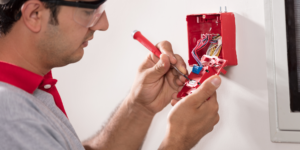Imagine a fire breaking out while you’re going about your day. Seeing smoke and flames on the walls causes panic. Be patient! Fire sprinklers across the structure are familiar. You feel relieved until you see a life-saving sprinkler is blocked by a nearby object. Uh-oh!
A simple scenario might soon become a calamity due to fire sprinkler clogs. Fire safety requirements for nonstructural objects must be understood. We’ll investigate why these obstacles are so problematic and how to prevent them.
What is a fire sprinkler obstruction?
Fire sprinkler impediments are any items, intentional or not, that prevent them from working. They can be decorations, storage, apparel, or signage. An obstacle is anything near a sprinkler head that could prevent it from activating or distributing water.
Fire sprinkler obstructions include hanging ornaments and placards. These items near sprinkler heads can block water in a fire emergency. Storage objects stacked too high near a sprinkler head might also hinder the spray pattern or water flow.
Even innocent items like streamers and balloons can be dangerous near fire sprinklers. In an emergency, active sprinklers can turn these lightweight things into projectiles, causing injury or damage.
Obstructions may be constructed for aesthetics or convenience without considering fire safety. This disrespect for rules endangers life and is illegal.
Keeping fire protection systems working in any facility requires knowing what an impediment is. By being aware of potential threats and following sprinkler nonstructural object guidelines, we can greatly reduce the risk of disaster during a fire emergency.
What are the rules for nonstructural objects?
Fire sprinkler systems need to be clear to work properly. Nonstructural objects might be dangerous if they block water flow during a fire. Rules govern how nonstructural things should be placed near fire sprinklers to avoid this risk.
First, avoid placing nonstructural objects below or 18 inches horizontally from sprinkler heads. If a fire starts, this distance lets water spread and cover the area. These items shouldn’t be higher than 12 inches below the ceiling or impediment.
Also, avoid hanging anything from sprinkler pipes or fittings. Any weight added to these components could damage them and slow system functioning in an emergency.
In addition to these standards, nonstructural objects must not impede fire sprinkler valves or control systems. Maintenance and emergency response require easy access to these components.
These restrictions for nonstructural objects around fire sprinklers can assist your building’s firefighting capabilities to work well. Everyone is responsible for safety!

Why are fire sprinkler obstructions a problem?
Fire safety is threatened by sprinkler blockages. These obstructions can prevent fire sprinklers from working, causing disaster. Fire sprinkler blockages hinder water flow during a fire emergency, which is why they are a worry. Blocking or hanging decorations or storage items near sprinkler heads hinders their effectiveness in dousing flames.
These obstructions can cause false alarms and delayed fire activation in addition to blocking water flow. Dust and grime on sprinkler heads might set off unneeded alarms or prevent them from functioning. This response time delay can endanger occupants and property.
Obstructions surrounding fire sprinklers contravene national building codes, which require automatic suppression system coverage. These laws are necessary to ensure that buildings have reliable and functional fire extinguishers.
To reduce fire sprinkler blockage threats, qualified personnel must inspect regularly and take action. Education and understanding of obstructions among building inhabitants is also crucial.
All property owners and managers should prioritize code compliance since it affects facility safety. We can respond faster to emergencies and save lives and property by preventing obstacles around fire sprinklers.
How can you prevent fire sprinkler obstructions?
Fire sprinkler blockages must be avoided for building safety. Here are some sprinkler system obstruction prevention tips.
Clear the area around each sprinkler head. Avoid placing furniture, equipment, or other items under or near sprinklers. They can perform properly and respond promptly to fires.
Preventing obstacles requires regular inspections and maintenance. Have a professional inspect and maintain all sprinkler system components. This includes inspecting for leaks, corrosion, and damage that could obstruct water flow.
Inform employees or residents about proper storage to avoid storing items near sprinklers. Encourage children to clean hallways and stairs.
Be careful when renovating or adding to your building. Check with fire protection experts to make sure these improvements won’t block sprinklers.
These preemptive steps can considerably reduce obstruction and maximize fire sprinkler system efficacy, keeping everyone safer in an emergency!

Conclusion
Building safety depends on unobstructed fire sprinklers. Decorations and storage items can accidentally disrupt these life-saving mechanisms. Follow a few easy principles to avoid fire sprinkler obstacles and keep the environment safe.
Keep areas around sprinkler heads clean of stacks and hanging things below them. When installing furniture or shelving near sprinkler heads, follow local fire code height and depth requirements.
To find and remove fire sprinkler obstructions, regular inspections and maintenance are needed. This involves inspecting for dust, debris, and other obstructions.
Instruct building occupants to keep nonstructural objects away from fire sprinklers. Encourage everyone to report blockages quickly so they can be fixed.
Preventing fire sprinkler obstructions is about protecting lives and property, not just following laws. You help keep your residents and employees safe by proactively removing potential hazards.
Keep an eye out for fire sprinkler obstacles since every second counts when safeguarding what matters most!
